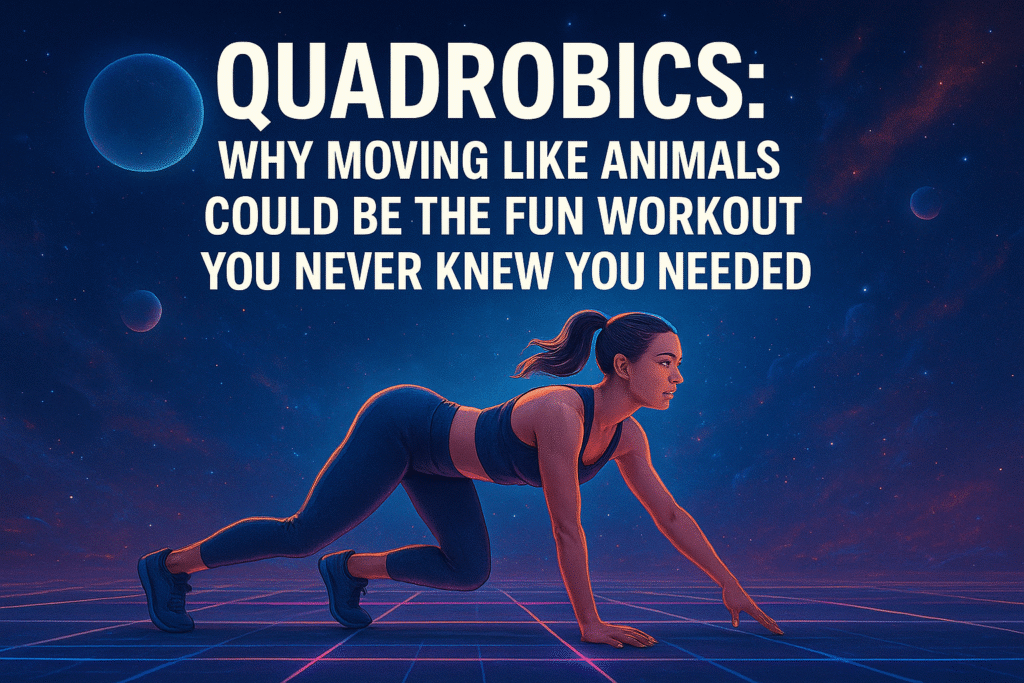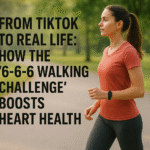Tired of the gym? Discover Quadrobics, the wildly fun fitness trend where you move on all fours like an animal. Learn how this primal workout builds incredible strength, improves mobility, and boosts mental health in our ultimate guide.
Unleashing Your Inner Animal
The fitness world is constantly evolving, but its latest trend feels less like an innovation and more like a homecoming. In parks and on social media feeds, a fascinating sight is becoming more common: people moving with a powerful, graceful, and uncannily animalistic gait. They are bounding, crawling, and leaping on all fours. This isn’t a flash mob or performance art; it’s a legitimate and rapidly growing fitness discipline called Quadrobics.
Emerging from niche online communities and exploding into the mainstream via TikTok and Instagram, Quadrobics (a portmanteau of “quadrupedal” and “aerobics”) is the practice of mimicking animal movement patterns for exercise. It draws inspiration from the natural world—the powerful prowl of a big cat, the agile bound of a fox, the stable crawl of a bear.
But this is far more than just playful imitation. Proponents and fitness experts are hailing it as one of the most holistic, functional, and downright enjoyable forms of exercise to emerge in years. It challenges the very notion of what a workout should be, trading sterile machines for primal patterns and repetitive reps for expressive movement. This article will be your definitive guide to Quadrobics, exploring its surprising benefits, its scientific underpinnings, and how you can safely tap into this powerful, fun, and transformative way to move your body.
What Exactly is Quadrobics? Beyond the Viral Videos
While seeing people “fox-trot” in a park might seem bizarre at first glance, Quadrobics is a structured practice with a clear purpose.
Defining the Discipline:
At its core, Quadrobics is a bodyweight exercise modality performed on all fours (hands and feet) that emphasizes fluid, dynamic, and rhythmic movement patterns inspired by quadrupedal animals. It differs from standard bear crawls or crab walks by its focus on gait cycles—specific sequences of limb movement—and an almost dance-like flow.
The Key Animal Gaits:
Practitioners learn and master several core gaits, each with unique benefits:
- The Fox Trot/Bound: A light, springy gait where the limbs move in diagonal pairs (right hand + left foot, then left hand + right foot). It’s fast, efficient, and emphasizes cardiovascular endurance and coordination.
- The Lynx/Lope: A more powerful, covering-ground gait with a moment of suspension (all four limbs off the ground). It builds explosive power and full-body strength.
- The Walk: A slow, controlled, four-beat gait (right hand, left foot, left hand, right foot) used for warm-ups, cool-downs, and mastering balance and weight distribution.
- The “High-Speed” or Run: An advanced, high-tempo version of the bound, requiring significant strength, coordination, and cardio capacity.
Origins and Evolution:
While the term “Quadrobics” is new, the concept is ancient. Humans are, biologically, fantastic quadrupeds. Our primate relatives move this way, and even human infants crawl with a natural diagonal gait. The modern practice pulls from:
- Parkour and Freerunning: Which incorporate ground movement and agility.
- Capoeira: For its fluid, animal-inspired ginga and ground sweeps.
- Animal Flow® and Primal Movement: Structured programs that popularized the concept of animal locomotion for fitness.
- Online Furry and Therian Communities: Where the practice was organically developed and shared, leading to its current viral status.
The Primal Payoff – The Surprising Science of Benefits
The genius of Quadrobics lies in its compound nature. A single session engages your entire being—physically, neurologically, and mentally.
1. Full-Body Functional Strength (No Weights Needed)
Moving your bodyweight against gravity on all fours is incredibly demanding. It builds functional strength that translates directly to daily life.
- Upper Body & Core: Your shoulders, arms, chest, and back must work synergistically to support your weight. Your core—abs, obliques, lower back—is engaged isometrically the entire time to prevent your spine from sagging, building a rock-solid midsection.
- Lower Body & Glutes: The pushing motion from the legs and feet powerfully engages the quads, hamstrings, and, most notably, the glutes. The hip extension required in bounding is one of the best possible glute activation exercises.
- Grip and Forearm Strength: Supporting your weight on your hands dramatically improves grip endurance and forearm strength.
2. Unmatched Mobility and Joint Health
Quadrobics takes your joints through their full, natural range of motion.
- Spinal Health: The rhythmic flexion and extension of the spine during movement acts as a dynamic massage, improving circulation to spinal discs and combating the stiffness caused by prolonged sitting.
- Shoulder and Hip Mobility: The movement patterns require deep flexion and extension in the hips and a stable yet mobile range in the shoulders, promoting joint health and preventing impingements.
3. Cardiovascular and Metabolic Conditioning
A sustained session of bounding and loping will get your heart rate soaring into the aerobic zone, making it an excellent tool for improving cardiovascular health and burning calories. It’s essentially a form of High-Intensity Interval Training (HIIT) if performed in bursts.
4. Neurological Fitness: The Ultimate Coordination Hack
This is perhaps its most unique benefit. Quadrobics is a neurological fire drill.
- Cross-Lateral Patterning: The diagonal limb movement (contralateral pattern) forces communication between the left and right hemispheres of your brain. This improves overall coordination, cognitive function, and has even been linked to improved reading and language skills.
- Proprioception and Kinesthetic Awareness: You must be acutely aware of where your limbs are in space without looking at them. This dramatically improves balance, agility, and reaction time.
- Neuroplasticity: Learning new and complex movement patterns like animal gaits creates new neural pathways, keeping your brain sharp and adaptable.
5. Mental and Emotional Liberation
The psychological benefits are just as compelling.
- Playfulness and Joy: Quadrobics is inherently fun. It taps into a sense of play often lost in adulthood, reducing stress and releasing endorphins.
- Mind-Body Connection: The practice requires intense focus on the movement itself, creating a state of “flow” or moving meditation that can alleviate anxiety and quiet a busy mind.
- Confidence and Self-Expression: Mastering a physically challenging and unconventional skill builds immense confidence. The expressive nature of the movement allows for creativity and individuality.
A Workout in Disguise – Comparing Quadrobics to Traditional Training
| Feature | Traditional Gym Workout | Quadrobics Session |
|---|---|---|
| Strength | Isolated muscle focus (e.g., bicep curls, leg press) | Integrated, functional strength across chains |
| Cardio | Separate session (treadmill, bike) | Built-in cardio through continuous movement |
| Mobility | Often requires separate stretching/yoga | Mobility is inherent to the movement patterns |
| Skill/Neuro | Minimal (repeat simple motions) | High neurological demand, improves coordination |
| Fun Factor | Can feel like a chore | High; feels like play, outdoors often |
| Equipment | Often requires weights/machines | None; just your body and open space |
| Mind-Body | Can be mindless | Deep connection and focus required |
As the table shows, Quadrobics offers a condensed, holistic training effect that would require multiple traditional modalities to replicate.
How to Get Started – Your First Quadrobics Session
Ready to try? Here’s a safe and effective progression.
What You Need:
- Space: A soft, open area like a grassy park, a sandy beach, or a padded gym floor. Avoid concrete at first.
- Clothing: Comfortable, flexible clothing that allows for a full range of motion.
- Footwear: Barefoot or minimalist shoes (like Vibram FiveFingers or Merrell Vapor Gloves) are ideal to allow your feet to grip and feel the ground. Avoid thick-soled running shoes.
- Protection: Light gloves (like fitness gloves) can protect your palms when starting out.
The Step-by-Step Progression:
Phase 1: Foundation (The Static Hold)
- The “Box” Position: Start on all fours with your hands directly under your shoulders and knees under your hips. Keep your back flat like a table. Engage your core.
- Goal: Hold this position for 30-60 seconds, focusing on stability and breathing.
Phase 2: Introduction to Movement (The Walk)
- From the box position, begin to move slowly.
- Pattern: Right hand, left foot, left hand, right foot. Move each limb individually.
- Focus: Keep your core tight and your back flat. Move slowly and with control. Practice moving forward, backward, and side-to-side.
Phase 3: The Dynamic Gait (The Fox Trot/Bound)
- This is the classic Quadrobics gait.
- Pattern: Move diagonal pairs together. Push off with your left foot and right hand simultaneously, landing on your right foot and left hand. Then repeat on the opposite side.
- Cue: Think “light and springy.” Try to create a rhythmic, bouncing motion.
- Start Small: Practice for just 20-30 second intervals, then rest.
Sample Beginner Session:
- Warm-up (5 mins): Light jogging, arm circles, leg swings, cat-cow stretches.
- Skill Practice (10 mins): 3 sets of Box Position hold (30 sec hold, 30 sec rest). Then, practice the Walk gait slowly for 3-4 lengths of your space.
- Workout (10 mins): 5 rounds of: [30 seconds of Fox Trot bounding, 60 seconds of rest].
- Cool-down (5 mins): Static stretching for hips, hamstrings, shoulders, and wrists.
Safety and Common Mistakes to Avoid
- Listen to Your Wrists: Wrist pain is common for beginners. If you feel pain, spend more time in the box position to build strength. You can also do reps on your fists to reduce the angle.
- Protect Your Spine: The most common mistake is letting the lower back sag into a “U” shape. Always engage your core to maintain a neutral spine.
- Start Slow: Don’t try to emulate the speed and height of advanced practitioners on day one. Master the pattern slowly before adding speed and power.
- Surface Matters: Start on soft ground to be kind to your joints.
- Consult a Professional: If you have pre-existing wrist, shoulder, or back issues, consult a physical therapist or trainer before beginning.
Conclusion: Reclaiming Movement
Quadrobics is more than a workout; it’s a movement philosophy. It asks us to forget reps and weights for a moment and remember what it feels like to move with grace, power, and joy. It reconnects us to our bodies in a profound way, building not just muscle, but coordination, resilience, and a vital sense of play.
In a world of sedentary lifestyles and repetitive exercise routines, Quadrobics offers a thrilling, effective, and holistic alternative. It proves that the most advanced fitness tool isn’t a machine—it’s the primal, agile, and powerful body you already have. So find a quiet patch of grass, get on all fours, and discover the fun, functional, and fantastic workout you never knew you needed.


